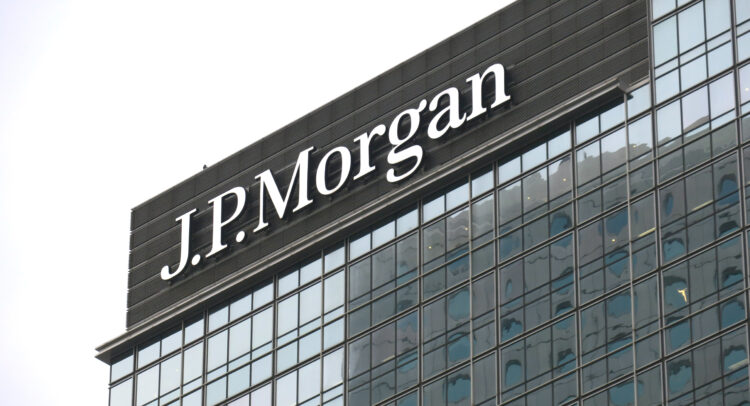JPMorgan (JPM) shares have performed well since the bank missed its earnings expectations last week. Interestingly, higher provisions for potential credit losses didn’t send the stock into a nosedive. Personally, I think JPMorgan is trading near fair value. It’s expensive compared with its peers, but given its dominant market position, it probably deserves some of that premium valuation. However, with the possibility of its revered CEO leaving in the near term and inflation still hovering over the economy, I’m neutral on the stock.
JPMorgan’s Results
JPMorgan reported Q2 earnings below Wall Street expectations and increased its provisions for potential credit losses. Despite this, investment banking fees and market revenues improved, admittedly from a low base. The bank’s stock slipped immediately following the results but made impressive gains and climbed 6% over five days.
As mentioned, JPMorgan missed the mark on earnings but outperformed expectations for revenue. The Q2 non-GAAP earnings per share (EPS) was $4.40, down from $4.63 in Q1 but up from $4.37 in Q2 2023. Adjusted revenue for Q2 was $51 billion, significantly higher than $42.5 billion in Q1 and $42.4 billion a year ago. Looking ahead, JPMorgan maintained its full-year net interest income guidance at $91 billion and kept its adjusted expense guidance unchanged at around $92 billion.
Chairman and CEO Jamie Dimon highlighted the very positive 50% rise in investment banking fees and a 10% increase in market revenue. However, the provision for credit losses surged to $3.05 billion, surpassing expectations. Total loans slightly increased, while deposits saw a minor decline. Finally, non-interest expenses rose compared to the previous quarter and the prior year.
What Did We Learn From JPMorgan’s Results?
JPMorgan Chase’s Q2 results paint a complex picture of the bank’s current position and future prospects. The bank’s higher provisions for expected credit losses at $3.05 billion suggest that JPMorgan anticipates a rough patch for the U.S. economy and a higher rate of borrower defaults, particularly in its massive credit card business.
CFO Jeremy Barnum pointed out that while there is some weakness in the lower-income segment, the overall consumer base remains healthy, and current economic trends suggest a slower economy and a soft landing rather than significant deterioration.
However, Dimon emphasized the bank’s cautious stance on future risks, including inflation, interest rates, and geopolitical uncertainties. “The geopolitical situation remains complex and potentially the most dangerous since World War II. though its outcome and effect on the global economy remain unknown,” Dimon said.
The mercurial financier also acknowledged that while stock and bond valuations reflect a benign economic outlook, multiple inflationary forces remain. “There has been some progress bringing inflation down, but there are still multiple inflationary forces in front of us: large fiscal deficits, infrastructure needs, restructuring of trade, and remilitarization of the world,” he added.
For now, it’s a pretty damning task to foresee what the immediate future will look like for JPM, but if we were to read between the lines of its CEO and CFO remarks, we can assume the company’s future outlook is a cautionary one. Some things are in the bank’s control, and other global issues, such as ongoing inflation and geo-political unease, make for a difficult conclusion. A far more immediate concern lies with its CEO’s prospects.
Is JPMorgan’s Dimon Leaving?
For many, Jamie Dimon is central to JPMorgan’s success in recent years. The stock is up around 7x since he took over as head of the bank in 2006. However, JPMorgan will need to plan for a future without Dimon. The company’s earnings preview noted that Dimon would likely leave in the next few years.
One of his future destinations could be the Treasury Office. Despite calling Dimon “an overrated globalist” just last year, Republican Presidential nominee Donald Trump recently said he would consider the JPMorgan boss for the position if he won on November 5. While Trump said he would not try ousting Federal Reserve Chair Jerome Powell, it’s worth considering a scenario whereby Dimon’s exit is expedited.
JPMorgan’s Valuation
Despite outperforming on revenue in Q2 and a strong track record in recent years, I don’t find JPMorgan’s valuation overly attractive. The stock trades at 12.7x forward earnings and has a price-to-earnings-to-growth ratio of 3.08. As a UK-based investor, I find these figures to be too dear. JPMorgan trades at a considerable premium to Britain’s banks, including those more diversified.
Is JPMorgan Stock A Buy According To Analysts?
On TipRanks, JPM comes in as a Moderate Buy based on 16 Buys, six Holds, and zero Sell ratings assigned by analysts in the past three months. The average JPMorgan stock price target is $219.44, implying a 1.1% upside potential.
The Bottom Line On JPMorgan Stock
JPMorgan stock is trading near fair value, as indicated by the average share price target and the valuation metrics. In fact, I don’t believe the valuation metrics are desirable at all. Still, I accept that the biggest bank in the world’s strongest economy, with a mercurial CEO, should rightly trade at a premium.
The company’s recent results were mixed, and its CEO and CFO comments shed some light on its cautionary approach for the near-term future. However, it’s interesting to see the stock trending higher over the past week despite increased loss provisions. To conclude, for now, I remain neutral about JPM stock.


















